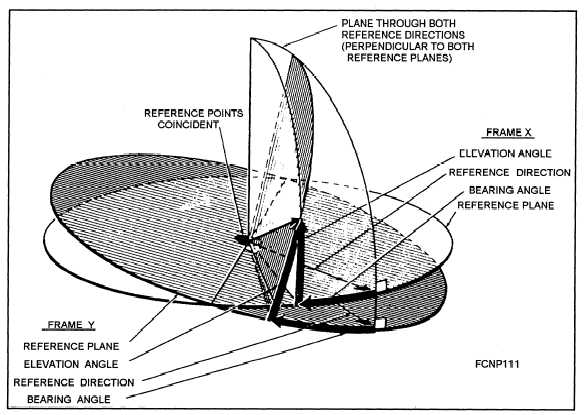Elevation angles also are affected by displace-
ments between reference frames. If elevation angles
measured in one frame are to be used in another
frame, they must first be corrected for parallax. The
magnitudes of parallax corrections in train and eleva-
tion vary considerably with target bearing, elevation,
and range, and the magnitude and orientation of the
distance between the reference frames.
The basic point to remember is that whenever two
reference frames are displaced from each other, data
measured from one frame is, in general, not equal to
data measured from the other frame. If the differences
are significant, data measured in one frame must be
corrected for parallax before it is applied in other
frames.
Angular Displacement
Connections arising from reference directions or
reference planes not being parallel are called rota-
tional corrections. If the reference lines are both in a
plane that is perpendicular to both reference planes,
but the reference planes are not parallel, the bearing
angles and the elevation angles are different.
When the angle between the reference planes is
relatively small, the major difference is in the ele-
vation angles; the difference in the bearing angles is
usually small enough to be ignored.
Figure 3-6 shows rotational corrections between
unparallel planes.
Figure 3-6.—Rotational corrections between unparallel planes.
ALIGNMENT EQUIPMENT
Alignment equipment is used by shipboard and
shipyard personnel to align combat systems elements.
Combat systems alignment checks and adjustments
are usually accomplished with tools and test equip-
ment normally found aboard ship. Because of required
combat systems accuracy, special-purpose instruments
are sometimes required for adjustments.
This section briefly describes the most commonly
used alignment equipment, such as transits, theod-
3-5


